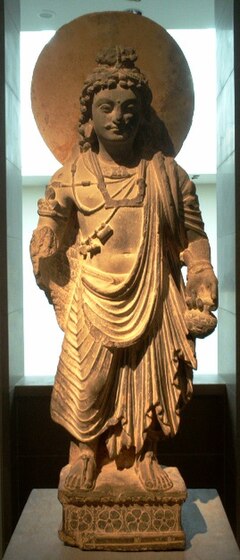Maitreya
| Maitreya Buddha | |
|---|---|

Maitreya from Gandhara, 2nd Century
|
|
| Sanskrit | मैत्रेय (Maitreya) |
| Pāli | Metteyya |
| Burmese | အရိမေတ္တယျ [ʔəɹḭmèdja̰] |
| Chinese | 彌勒菩薩 (Mílè Púsa) |
| Japanese | 弥勒菩薩 (Miroku Bosatsu) |
| Korean | 미륵보살 (Mireuk Bosal) |
| Mongolian | ᠮᠠᠶᠢᠳᠠᠷᠢ᠂ ᠠᠰᠠᠷᠠᠯᠲᠣ; Майдар, Асралт; Mayidari, Asaraltu |
| Okinawan | 弥勒御迎 (Miruku Unkee) |
| Shan | ဢရီႉမိတ်ႈတေႇယႃႉ |
| Sinhala | මෛත්රී බුදුන් (Maithri Budun) |
| Thai | พระศรีอริยเมตไตรย (Phra Si Ariya Mettrai) |
| Tibetan | བྱམས་པ་ |
| Vietnamese | Di-lặc (bồ-tát) |
| Information | |
| Venerated by | Mahayana, Theravada, Vajrayana |
| Attributes | Great Benevolence |
| Preceded by | Gautama Buddha |
|
|
|
Maitreya (Sanskrit), Metteyya (Pali), Maithri (Sinhalese), Jampa (Wylie: byams pa) or Di-lặc (Vietnamese), is regarded as a future Buddha of this world in Buddhist eschatology. In some Buddhist literature, such as the Amitabha Sutra and the Lotus Sutra, he is referred to as Ajita.
According to Buddhist tradition, Maitreya is a bodhisattva who will appear on Earth in the future, achieve complete enlightenment, and teach the pure dharma. According to scriptures, Maitreya will be a successor to the present Buddha, Gautama Buddha (also known as Śākyamuni Buddha). The prophecy of the arrival of Maitreya refers to a time in the future when the dharma will have been forgotten by most on the terrestrial world.
Maitreya has also been adopted for his millenarian role by many non-Buddhist religions in the past, such as the White Lotus, as well as by modern new religious movements, such as Yiguandao.
The name Maitreya is derived from the Sanskrit word maitrī "loving-kindness", which is in turn derived from the noun mitra "friend". The Pali form Metteyya is mentioned in the Cakkavatti-Sīhanāda Sutta (Digha Nikaya 26) of the Pāli Canon, and also in chapter 28 of the Buddhavamsa. Most of the Buddha's sermons are presented as having been presented in answer to a question, or in some other appropriate context, but this sutta has a beginning and ending in which the Buddha is talking to monks about something totally different. This leads scholar Richard Gombrich to conclude that either the whole sutta is apocryphal or that it has at least been tampered with.
...
Wikipedia
